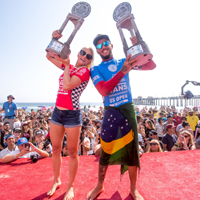
More fashion and footwear brands are raising the stakes when it comes to their initiatives towards sustainability. Like H&M and Kering, leaders in this category, so too has Adidas stepped up their game.
This week, the adidas Group announced a partnership with Parley for the Oceans, an initiative dedicated to raising awareness about the beauty and fragility of the oceans and to collaborating on projects that can end their destruction. Together, the adidas Group and Parley for the Oceans will implement a long-term partnership programme that builds on three pillars: Communication and Education, Research and Innovation as well as Direct Actions against Ocean Plastic Pollution.
The partnership is an example of the adidas Group’s open-source innovation approach, to engage with partners, crowd-source ideas and co-create the future of the industry. Among others, this collaboration will accelerate the creation of innovative products and integration of materials made of Ocean Plastic waste into the product offer of the adidas brand as of 2016.
“The conservation of the oceans is a cause that is close to my heart and those of many employees at the adidas Group,” said Eric Liedtke, adidas Group Executive Board member responsible for Global Brands. “By partnering with Parley for the Oceans we are contributing to a great environmental cause. We co-create fabrics made from Ocean Plastic waste which we will integrate into our product.”
“Our oceans are about to collapse and there is not much time left to turn it around. Nobody can solve this alone. Everyone has to be part of the solution. And collaboration is the magic formula,” said Cyrill Gutsch, founder of Parley for the Oceans. “We are extremely excited about this partnership. There is no other brand that carries the culture of collaboration in the DNA like adidas. Together, we will not only focus on creating the next generation of design concepts, technologies, materials and products. We will also engage consumers, athletes, artists, designers, actors, musicians, scientists and environmentalists to raise their voice and contribute their skills for the ocean cause.”

This partnership builds on the company’s strong track record in product sustainability, one of the key pillars of the adidas Group’s sustainability strategy. Constantly looking into new and smarter ways to make its products better, this collaboration will also further strengthen the company’s ties with its consumers by allowing them to be part of the solution via retail and future activations. As a first action, the adidas Group has also decided to phase out the use of plastic bags in its own retail stores.
“In 2014 we brought sustainability to our own stores when we introduced our first ‘green’ retail concept in our HomeCourt store in Nuremberg, Germany,” stated Frank Henke, adidas Group Vice President for Global Social and Environmental Affairs. “The partnership with Parley for the Oceans has already led us to reassess some of our business practices. Stopping the use of plastic bags in our stores is a primary example of this and the right thing to do.”
The announcement comes with the publication of the 2014 adidas Group Sustainability Report, the 15th published by the company so far. The report is an annual overview of achievements and challenges as well as a progress update on the company’s 2015 sustainability targets. Some highlights of the 2014 Sustainability Progress Report include:
PEOPLE
• In 2014, the company revised its Code of Conduct for its employees.
• The SMS Worker Hotline, launched at the end of 2012, was expanded to a total of twenty-five factories across Indonesia and Vietnam, covering roughly 160,000 factory workers.
• Employee volunteering hours achieved an all-time record, with a total of 28,750.
PRODUCT
• The product offer integrating DryDye fabric has steadily increased, reaching four million yards of DryDye fabric produced by the end of 2014, and saving 100 million litres of water. Limited to apparel so far, this game-changing technology will be introduced to footwear in the 2016 adidas Spring/Summer collection.
• In 2014, the adidas Group used more sustainable cotton than ever before, as the company sourced more than 30% of all its cotton as Better Cotton, exceeding the originally planned 25% target. The adidas Group has committed to source 100% of cotton across all product categories in all its brands as sustainable cotton by 2018.
• Increasing quantities of recycled polyester have been integrated into the product offer, with key products being the 2014 Anthem jackets used as warm-up jackets for a range of sports (e.g. Real Madrid and Bayern Munich in football).
PLANET
• The company opened its first ‘green’ retail concept in the HomeCourt store in Nuremberg, Germany. The store is equipped with a number of resource- and energy-saving features and installations.
• A total of 143 environmental audits were performed at the Group’s suppliers. This number includes specific chemical management audits.
• The increasing use of virtual samples allowed the Group to save more than 1.9 million physical samples between 2011 and 2014.
PARTNERSHIP
• To further improve its chemical management program, the adidas Group entered into a strategic partnership with bluesign technologies. This partnership is already bringing multiple benefits such as the even more responsible use of resources in the manufacturing process.
• To achieve convergence and consistency of monitoring tools, the Sustainable Apparel Coalition (SAC) Higg 2.0 Index Environmental Facility Module was integrated into the company’s environmental supply chain work, replacing the current environmental audit tool.
• In 2014, the adidas Group celebrated 15 years of partnership with the Fair Labor Association.
Looking ahead, the adidas Group will focus on:
• Driving self-governance in the company’s supply chain, which gives suppliers higher responsibility to manage their downstream supply chains and move towards public reporting.
• Accelerating strategic initiatives in the following areas: further promoting worker empowerment, moving the company’s chemical management program to the next level, minimizing the adidas Group’s water footprint as well as applying human rights due diligence in all business operations.
• Engaging with consumers around the topic of sustainability.
About the adidas Group’s approach to sustainability:
The adidas Group’s sustainability strategy is rooted in the Group’s values – performance, passion, integrity and diversity. It is built on the achievements and learnings from previous years, while taking into account the societal landscape and future global trends. The four pillars of the adidas Group’s strategy are:
• People: We positively influence the lives of our employees, factory workers and people living in the communities where we have a business presence.
• Product: We find better ways to create our products – mainly through innovation, increased use of more sustainable materials and efficiencies.
• Planet: We reduce the environmental footprint of both our own operations and our suppliers’ factories.
• Partnership: We engage with critical stakeholders and collaborate with partners to improve our industry.
For more information about the adidas Group’s continuing efforts, visit here.


